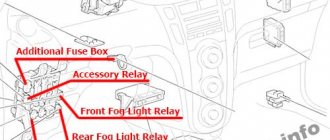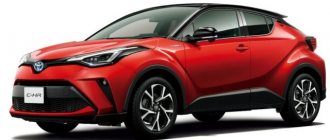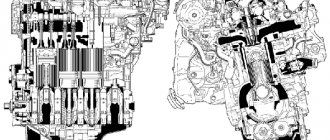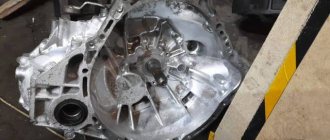Japanese and European Toyota Vitz
Toyota Vitz II was released at a time when there was no widespread unification of models in all parts of the world. Therefore, the versions for the Japanese and European markets were very different in technical content. This mainly concerns the line of power units and transmissions. See:
The European version is simpler in everything related to engines and transmissions. Instead of so-so CVTs and good automatic transmissions, they had the “legendary” Toyota robot: twitchy, slow, and fragile.
The original “Japanese” did not suffer from these ailments. And in general there is more of it on the secondary market. At the same price, it's worth noting.
Apparently, due to liquidity or a more transparent history, right-hand drive cars were often imported as a set of designer spare parts. The “white” ones were purchased from official dealers and may have been better serviced.
Also read: The whole truth about the Toyota Prius II hybrid (XW20)
Test drive Toyota Vitz. Review of the Toyota Vitz 1.5RS
Old racer
Toyota Vitz RS is a car equipped with the most powerful engine for the Vitz family, the displacement of which is as much as 1.5 liters. Both inside and outside it has a lot of additionally installed parts and specially designed components that are designed to emphasize the sporty orientation of this car. For example, a special design of seats with side supports built into the backrests, which together with the seats provide the driver with a straight seat and, thus, give him the opportunity to look down on the road. Or an engine that, no matter what speed you drive it at, doesn’t give all its best. Or the good grip shift knob and suspension that keeps the tires firmly in contact with the road and is so smooth at the same time! Intense acceleration, which is due to the low gear ratio and evenly distributed torque - all this deserves the highest marks. And yet, it’s somehow impossible to classify this car as a classic of the “sports” genre. I just want to write: “Even though I’m a racer, I’m getting old.”
But you can look at things from the other side. The 1.5-liter engine that powers this Vitz has Variable Valve Timing (VVT-i) at its disposal. And this allows him to move the 940 kg car quite energetically even when the tachometer shows only 2000 rpm. A very useful innovation that dramatically increases the capabilities of the motor.
Even on city streets with their turns and idling in traffic jams and at intersections, fuel consumption will barely exceed one liter for every 10 kilometers driven. And what a smooth, comfortable ride, which is not at all typical for models that are usually classified as cars “for everyday trips”! And the ease with which you can adjust or unfold the seats also adds practicality to the car.
All that remains, apparently, is to choose the right advertising slogan for it, for example: “Intelligent, matured, compact,” and then, perhaps, all the positive aspects of the new model will sparkle with new colors.
General information about the machine
Vitz is, as you know, a compact car developed by Toyota, which appeared on the market in January 1999. This machine is quite reasonably considered as a strategically important “tool” in the company’s struggle for Western sales markets. The Vitz body is a typical hatchback with three or five doors. It was initially equipped with a 1-liter or 1.3-liter engine. But, starting in October 2000, the Vitz line was supplemented with a modification with a more powerful 1.5 liter engine. The car can be equipped with either a 4-speed automatic or a 5-speed manual transmission. Finally, regarding the type of drive, in addition to cars with driven front wheels, there is an option with all-wheel drive. The model range includes a number of trim levels, namely the basic B, F, U, then the Clavia trim with retro elements, and finally the RS sports trim.
Vitz RS is a sports equipment of the base model, which in all its data copies the car of the Euro Sport Edition series. This vehicle is equipped with a 1.3 and 1.5 liter engine. The transmission can be a 4-speed automatic or a 5-speed manual transmission. Drive is provided only to the front wheels. The shape of the front and rear bumpers remains the same, but now they have a special color. As for the elements located inside the cabin, the instruments on the main panel, specially designed chairs, etc. attract attention here. Due to the increase in engine capacity, the suspension received additional rigidity, and the rear drum brakes were replaced with disc ones. In addition, the tire size has been increased (155/80 R13 is replaced by 185/55 R15).
Evaluation from the inside Interior equipment and front panel - 4 points
Inside the Vitz RS, the connoisseur will be pleased with the white dial speedometer, tachometer, two-tone steering wheel (a combination of black and gold) and the special shape of the gear lever handle. True, moving these devices closer to the middle of the front panel raises some doubts about its feasibility. In fact, now in order to find out what speed the engine is holding, the driver has to move his gaze and take his eyes off the road. That is, I do not want to say that this is completely unacceptable, but it will probably take the driver some time to get used to it. But in general, the entire structure of the front panel is very thoughtful, to the point that quite large niches for small items are built into the side of the middle console and below the steering column. And most importantly, they are easily accessible.
Front seats - 2 points
The interior uses special chairs with a single color color. The seats look very wide, but their curved shape attracts attention. Thanks to it, the driver’s body remains, I would say, in a mobile state, and this is not at all suitable for sports driving, since it does not allow the body to be fixed motionless. More precisely, the body can acquire a stable position if the driver has a decent weight. And if not? Without a doubt, the side supports included in the design of the backrests help maintain a “sporty” driver’s posture, but, nevertheless, their holding properties are not at all as good as it might seem at first glance.
The landing point is quite high, so it always feels like you're not sitting down properly. This can also be considered a shortcoming.
Rear seats - 4 points
The rear seats are very reminiscent of the seats in the Renault Twingo. They can be moved back or forward. The seats feel a little short and aren't very plump, but they're quite comfortable to sit in. Wide side windows create a feeling of spaciousness. As for the distance between the rear passenger's head and the ceiling, we tried to maintain it. But the ceiling goes down right behind the head of the seated passenger, so those who are tall may find it uncomfortable.
Luggage compartment - 2 points
When laying out the interior, all attention was paid to arranging the space around the rear seats, and as a result, the luggage compartment was not very spacious. In particular, it is only 40 cm deep, the distance from the floor surface to the rear door frame is 55 cm. The maximum width at floor level is 130 cm, but since the upper suspension mounting niches go into the cabin, the useful width of the trunk is much smaller. However, it should be noted that, thanks to the separate design of the backs of the rear seats, one of the halves can be easily tilted forward without removing the headrest. This means that the trunk capacity can be increased slightly. You can lift the rear seats themselves and throw them forward, then fold the backrests forward (double folding system). With this option, the luggage compartment benefits from an extra meter of depth.
How is the car running? Engine and transmission - 2 points
In fifth gear, the car moves at a speed of 100 km/h when the tachometer shows 3250 rpm. Thus, it can be stated that the gear ratio of the box is low, which means that driving at high speed will be accompanied by very significant engine noise. But within the city limits, this combination has a lot of advantages. At the very least, intense overclocking is guaranteed. Thanks to the VVT-i system, the 1NZ-FE engine has a smoothly increasing torque. At the same time, as already noted, the vehicle is expected to be driven frequently without being fully loaded, and therefore have a low overall weight. Therefore, it is possible that in order to maintain quite a decent speed, you do not have to force the engine to rotate too quickly. The gearshift lever has a long stroke, and the “switching on” of the desired gear is clearly noticeable. In general, the car is a “business” one.
Comfort and steering - 3 points
Both on the high-speed highway and within the city, the driver has a sufficient level of comfort, even if you do not take into account the sporty orientation of this car. Tires with a profile height of 55 mm absorb even very noticeable impacts well. The car has a ground clearance reduced by 15 mm, the front and rear suspension is equipped with anti-roll bars, so it does not reach a deep roll. Although this makes the ride less exciting. But still, entering a turn with a roll, if the driver sees the road a little from above, this is always invigorating and awakening. In short, this car is a pleasure to drive.
Overall score – 3 points
Test results
Reporting author: Aomori Teino. Test date: November 25, 2000 Type of vehicle tested: advertising sample. Year of manufacture of the tested vehicle: 2000. Total mileage at the time of testing: 1278 km. Tires: front and rear – 185/55R15 81V Bridgestone Potenza RE040. Optional equipment: optional overhead brake light (8,000 yen, or about $76). The purpose of the tests: to obtain a general idea of the behavior of the car on the move. Traffic schedule: city limits - high-speed highway - mountain road.
Technical specifications Toyota Vitz 1.5 RS
Body dimensions (length / width / height) 3630 mm / 1660 mm / 1485 mm Wheelbase 2370 mm Vehicle weight 940 kg Drive Front-wheel drive Engine 1.5-liter, 4-cylinder in-line, DOHC, 16 valves, variable speed power - 110 hp at 6000 rpm, maximum torque - 14.6 kg/m at 4200 rpm. Transmission 5-speed manual transmission Base price 1,453,000 yen (about $13,800) Price of the test drive 1,461,000 yen (about $13,900)
Author: Aomori Teino
2000 Source:
webCG
Translation:
AUTO.VL.RU When reprinting, a link to the sources of text and translation is required!
Drom.ru
Specifics of Toyota Vitz II (XP90) configurations
In terms of security systems, Vitz II took a step forward compared to its predecessor, but not immediately - after modernization in 2007. Then side airbags and curtains to protect the knees appeared on the list of options.
Japanese versions are more varied than European ones in terms of interior trim options: there is leather and various types of fabric combinations. The same goes for multimedia. The Japanese versions have a standard “head” with navigation (useless in Russia, but that’s a fact!). The European Witz's wealth ended with a radio with a CD/MP3 drive.
True, in the secondary market today this bothers few people. Judging by the advertisements, the owners through one added the benefits of civilization in the form of parking sensors and a rear view camera.
Also read: Middle or business class: Toyota Camry (XV40) review
Reviews of Toyota Vitz Rating: 4.4 out of 5 33 reviews found
01.04.2010
Hello to all car enthusiasts. So I decided to write a review about one of the cars. Toyota Vitz (Japanese) 2000. We took it in 2007 with a mileage of ~60,000 km. (I don’t know, maybe it was twisted). Before that, a girl rode it for about a year. That is, in Russia we turned out to be the second masters. The interior was in good condition, not smoked, the body had no traces of an accident, in general it was clear that the car had been taken care of. We didn’t even take her for diagnostics - we took the saleswoman’s word for it. They were young and inexperienced. I’ll say right away that we were lucky; the car really turned out to be in excellent condition. Color – metallic silver. The equipment is the simplest: “meat grinders” on the doors, black bumpers (very practical), 1l. ~70 hp, automatic transmission, air conditioning, display without tacho (and it’s not needed on an automatic), driver’s airbag. Mostly my wife drove it. We drove it for about 40 thousand in two years, and in December 2009 we successfully sold it to a friend with a mileage of 99,000 km. We sold it because we wanted left-hand drive and five doors (we had a three-door). There were no complaints regarding the technical condition. Now about the car. For two years, in addition to the scheduled oil and pad changes, the thermostat was changed, and we wanted to change the drive belt (it whistled), but at the station they tightened it up for us and said that we could still drive. One stop light has burned out. That's all. For the engine - timing chain. This made me very happy, and I think it will make the future owner happy too. Pikhlo, as I understand it, calmly accepts any normal oil (synthetic and semi-synthetic), the main thing is to know where to buy. The previous owner poured Castrol, we poured Shell, the last time we poured Eneos - also nothing. Didn't notice any difference. Salon. There is enough room in front (but not for legs) - with my height of 175 cm, I rode with the seat completely pushed back. The A-pillars slightly interfere with visibility when cornering, but this is a problem with many modern cars. The rear seat folds down to create a fairly large cargo compartment if desired. In general, the car is compact and roomy at the same time. The noise in the car is weak, the noise is almost inaudible, but the road noise is very good) But the interior itself does not creak AT ALL. At speed on bumps, the trunk door began to “moan” - I lubricated the lock with WD - and everything went away. By dynamics, or rather, by the lack thereof. The automatic transmission smothers the engine as best it can. Even with kickdown, it accelerates sluggishly and reluctantly: at about 4500 rpm (judging by the sound), it is in a hurry to get into the next gear (apparently it saves gasoline), so overtaking turns out to be somewhat strained. Uphill, I don’t hesitate to turn on “2”, otherwise it crawls reluctantly. What definitely pleases is the consumption: 7-8 liters per hundred (city), which is just excellent for our mountainous terrain and traffic jams (Sochi). I accelerated it to about 140, maybe more if I pushed the slipper, but it was scary to drive. In short, it accelerates slowly, but drives quickly. Before selling it, I changed the oil in the box along with the filter. The filter didn’t have to be changed (it’s mesh), but oh well, it cost 700 rubles on the market. I took the oil, which says Toyota T-IV. I don’t know original – not original, probably not, where do original Toyota oils come from in Sochi? 4 liters for 1300 rubles, did it at the station, partial replacement, without a device: drained the oil from the sump, removed the sump, cleaned it, replaced the filter, put everything back together, filled in oil (about 3.5 liters). In general, nothing like it. They took 1000 rubles for the work. It was possible to do it yourself (there were instructions in pictures on the drome), but I was reluctant to screw up the box before selling it. Still, this is not a Lada. When they started selling, they came twice (with potential buyers) for diagnostics. Both times the mechanic's eyes were wide open when, after the diagnosis, they found out the year of manufacture and mileage of the car. – no rust, no oil leaks. The chassis is all original. In general, forgive me if there are a lot of buffs, the car as a whole, I think, is excellent, worth the money. Two years later we sold it for the same amount as we bought it for. If you want to *carry your dad to work and are on a very limited budget, you don’t need more. If you want some drive, buy a Subarik or BMW.
Household features of Toyota Vitz II (XP90)
You don’t have to expect much comfort in the cabin: this is a small car at the junction of A- and B-classes. The wheelbase is only 2.5 m, so you have to put either guilty friends or small children back. If someone with the height of a mature man fits there, he will be deeply unhappy.
Don't look for sound insulation outside or silence inside the cabin. The tires will hum in your ears, the plastic is hard and will creak in the cold. But isn’t it too much to ask for 250 thousand rubles?
Residents of the outback may have problems with ground clearance. A modest 145 mm below the bottom point is not always enough to stand close to the curb.
But the overhangs are short, the wheels are placed in the corners, and this is enough to avoid snagging snags on the country road with your bumper and briskly weave through city traffic.
The Vitz is excellent with maneuverability, but not so much with cargo transportation. 250 liters of luggage space, even for Saturday trips to supermarkets, not to mention taking my hockey-playing son with his equipment to training.
But the trunk is organized competently and suggests the possibility of transformation. The back of the rear sofa folds in parts, which in those years was rare even in cars of a higher class. In the Polo and Fabia of that time, the back of the sofa could only be lowered completely, turning the car into a “truck”, but strictly a two-seater. The Vitz is smarter: one passenger in the back will still fit, even if you need to carry a long piece of luggage.
Fuel consumption is directly proportional to the frequency and depth of pressing the gas pedal, that is, each person has their own, taking into account their driving style. One thing is for sure: in rare versions with a torque converter automatic transmission, it will be higher than in “manual” and CVT ones. But often owners of “Japanese” Vitz with 1.0-1.3 engines talk about 6 liters in the city and 4 on the highway.
The most economical is the robotic European specification, but the savings are not worth all the troubles with the transmission.
Also read: Business class from the past: Lexus GS II 300 review
Toyota Vitz / Toyota Vitz
Vitz: parameters, tests (test drive, crash test), reviews, car dealerships, photos, videos, news.
Toyota Vitz
- production began in 2005. The combination of style and technology Vitz, created by Toyota, has proven itself in the market and is time-tested.
Among the existing basic colors of Vitz, you can easily find one that suits you, but most likely you can choose it to order. We most likely do not have all the configurations of this Toyota Vitz model, among which there are various Vitz assembly options: the gearbox can be automatic or manual, leather trim or wood inserts, wheels and other additional elements of the Vitz body, which will certainly be reflected in the price Vitz. Technical characteristics are good, but don’t forget about the safety of the Vitz or the engine size, which will then make itself felt in operating costs in the future, as well as Vitz repairs and maintenance with a warranty period. Since the purchase is made not for several months, but for several years, therefore, consider for yourself what you will do in the summer and winter, what trips to make on the Vitz
. The table below shows a comparison of several configurations of the Vitz, among the parameters are reflected: what are the overall dimensions of the Vitz, what is the fuel consumption in the city, highway or mixed, engine size, maximum speed and acceleration time to 100 km/h, curb or gross weight of the Vitz, wheelbase, front and rear wheel tracks, transmission type (gearbox/gearbox), what kind of drive, tire size, how much power or torque and what price. In addition to all the numbers, you can read reviews of car owners about Vitz, watch videos or news, tests (test drive, crash test).











